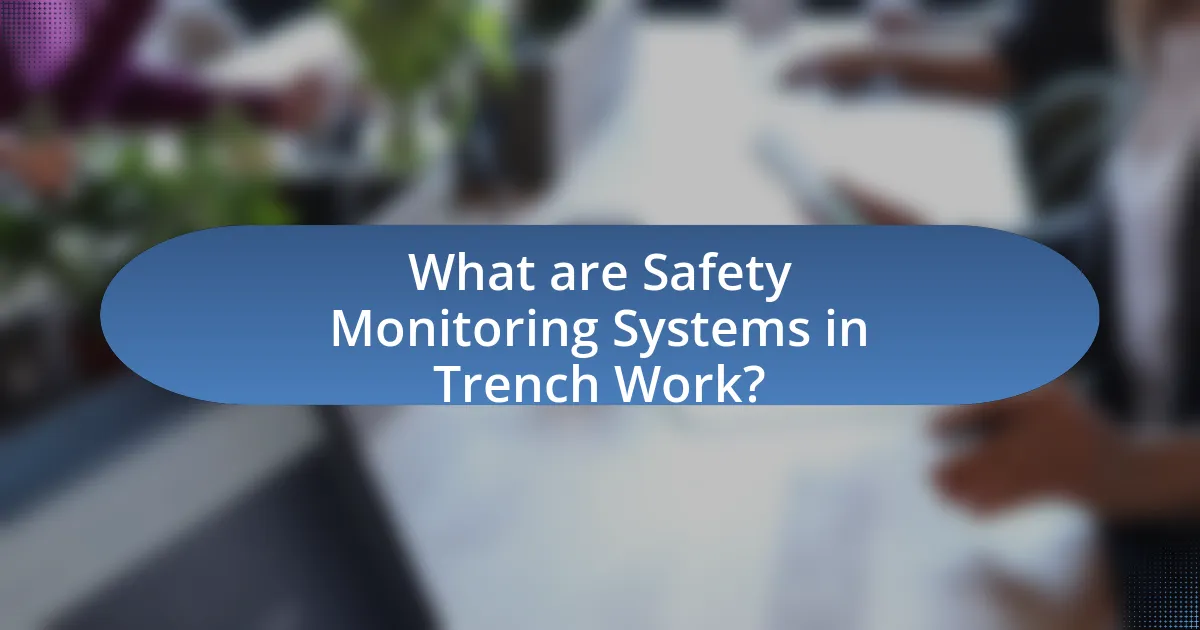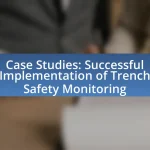Safety Monitoring Systems in trench work are essential frameworks designed to enhance worker safety by continuously assessing risks associated with trenching operations. The article analyzes the functionality, technologies, and key components of these systems, highlighting their role in preventing accidents and injuries through real-time monitoring and alerts. It also discusses regulatory requirements, costs associated with implementation, and the long-term financial benefits of these systems, including reduced accident-related expenses and lower insurance premiums. Furthermore, the article emphasizes best practices for effective implementation and the importance of continuous improvement strategies to maximize the value of Safety Monitoring Systems in trench work environments.

What are Safety Monitoring Systems in Trench Work?
Safety Monitoring Systems in trench work are specialized frameworks designed to ensure the safety of workers by continuously assessing and managing risks associated with trenching operations. These systems utilize various technologies, such as sensors and alarms, to monitor environmental conditions, soil stability, and worker movements, thereby preventing accidents and injuries. For instance, the Occupational Safety and Health Administration (OSHA) emphasizes the importance of such systems, noting that proper monitoring can significantly reduce the likelihood of cave-ins, which are a leading cause of fatalities in trench work.
How do Safety Monitoring Systems function in trench environments?
Safety Monitoring Systems function in trench environments by continuously assessing conditions to ensure worker safety. These systems utilize sensors to monitor factors such as soil stability, gas levels, and environmental conditions, providing real-time data to detect hazards. For instance, systems may include vibration sensors that alert workers to potential collapses or gas detectors that signal harmful gas concentrations. The integration of these technologies helps prevent accidents and injuries, as evidenced by studies showing a reduction in trench-related incidents when monitoring systems are employed.
What technologies are utilized in Safety Monitoring Systems?
Safety Monitoring Systems utilize technologies such as sensors, cameras, data analytics, and communication networks. Sensors detect environmental conditions like gas levels, temperature, and structural integrity, while cameras provide real-time visual monitoring. Data analytics processes the information collected to identify potential hazards and trends, and communication networks facilitate the transmission of alerts and data to relevant personnel. These technologies work together to enhance safety and prevent accidents in trench work environments.
How do these technologies enhance safety during trench work?
Technologies enhance safety during trench work by providing real-time monitoring and alerts for hazardous conditions. For instance, safety monitoring systems utilize sensors to detect soil stability, water accumulation, and gas leaks, which can prevent accidents. According to the Occupational Safety and Health Administration (OSHA), trench collapses are a leading cause of fatalities in construction, and implementing these technologies can reduce such incidents by up to 50%. Additionally, data analytics from these systems can help in planning and executing safer trenching operations, thereby minimizing risks associated with human error and environmental factors.
What are the key components of Safety Monitoring Systems?
The key components of Safety Monitoring Systems include data collection, risk assessment, incident reporting, and real-time monitoring. Data collection involves gathering information on safety conditions and worker activities, which is essential for identifying potential hazards. Risk assessment evaluates the likelihood and impact of identified hazards, allowing for prioritization of safety measures. Incident reporting systems facilitate the documentation and analysis of accidents or near misses, contributing to continuous improvement in safety protocols. Real-time monitoring utilizes technology to track safety compliance and environmental conditions, ensuring immediate response to any safety breaches. These components work together to enhance workplace safety and reduce incidents in trench work environments.
What sensors are commonly used in these systems?
Commonly used sensors in safety monitoring systems for trench work include soil moisture sensors, gas detectors, and vibration sensors. Soil moisture sensors assess the stability of the trench by measuring moisture levels, which can indicate potential collapse risks. Gas detectors monitor for hazardous gases such as methane or carbon monoxide, ensuring worker safety by detecting dangerous conditions. Vibration sensors track ground movement, providing real-time data on structural integrity. These sensors collectively enhance safety by providing critical information that helps prevent accidents in trench work environments.
How do data analytics play a role in monitoring safety?
Data analytics plays a crucial role in monitoring safety by enabling the collection, analysis, and interpretation of data related to safety incidents and conditions. Through real-time data analysis, organizations can identify patterns and trends in safety performance, allowing for proactive measures to mitigate risks. For instance, a study by the National Institute for Occupational Safety and Health (NIOSH) found that data-driven safety programs can reduce workplace injuries by up to 20%. By leveraging predictive analytics, companies can forecast potential safety hazards based on historical data, leading to improved decision-making and resource allocation in safety management.
What are the regulatory requirements for Safety Monitoring Systems in trench work?
The regulatory requirements for Safety Monitoring Systems in trench work are primarily governed by the Occupational Safety and Health Administration (OSHA) standards, specifically 29 CFR 1926 Subpart P, which outlines safety measures for excavation and trenching operations. These regulations mandate that employers implement systems to monitor trench conditions, including soil stability and potential hazards, to ensure worker safety. Additionally, the use of protective systems such as trench boxes or shoring is required when trenches exceed five feet in depth, and regular inspections must be conducted by a competent person to identify and mitigate risks. Compliance with these regulations is essential to prevent accidents and fatalities associated with trench work, as evidenced by OSHA’s statistics indicating that trench collapses are a leading cause of construction-related deaths.
Which organizations set these regulations?
The organizations that set regulations for safety monitoring systems in trench work include the Occupational Safety and Health Administration (OSHA) and the American National Standards Institute (ANSI). OSHA establishes safety standards to protect workers in various industries, including construction, while ANSI develops consensus standards that guide safety practices. These organizations ensure compliance with safety regulations to minimize risks associated with trench work, thereby enhancing worker safety and health.
How do compliance standards impact system implementation?
Compliance standards significantly influence system implementation by dictating the requirements that safety monitoring systems must meet to ensure worker protection in trench work. These standards, such as those set by OSHA, establish specific safety protocols and performance metrics that systems must adhere to, thereby shaping the design, functionality, and operational procedures of the systems. For instance, adherence to these standards can lead to the integration of advanced monitoring technologies that enhance safety, such as real-time data analytics and alert systems, which are essential for compliance. Furthermore, failure to meet compliance standards can result in legal penalties and increased liability, emphasizing the necessity for organizations to align their system implementations with these regulations to mitigate risks and ensure worker safety.

What are the Costs Associated with Implementing Safety Monitoring Systems?
The costs associated with implementing safety monitoring systems include initial setup expenses, ongoing maintenance fees, and training costs for personnel. Initial setup expenses can range from thousands to millions of dollars depending on the complexity of the system and the specific technology used, such as sensors and software. Ongoing maintenance fees typically account for 10-20% of the initial investment annually, ensuring the system remains functional and up-to-date. Training costs for personnel can also add to the overall expenditure, often requiring several hours of instruction and practical application to ensure effective use of the system. These costs are essential for ensuring compliance with safety regulations and reducing the risk of accidents in trench work environments.
What initial investments are required for Safety Monitoring Systems?
Initial investments for Safety Monitoring Systems typically include hardware, software, installation, and training costs. Hardware expenses can range from sensors and cameras to communication devices, often totaling several thousand dollars depending on the complexity of the system. Software costs involve purchasing licenses for monitoring applications, which can also be in the thousands. Installation fees may vary based on the site and system requirements, while training personnel to effectively use the system adds additional costs. Collectively, these initial investments can range from tens of thousands to over a hundred thousand dollars, depending on the scale and specifications of the Safety Monitoring System implemented.
How do equipment costs vary based on technology?
Equipment costs vary significantly based on technology, with advanced technologies typically resulting in higher initial costs but potentially lower long-term operational expenses. For instance, safety monitoring systems that utilize real-time data analytics and IoT connectivity often require a larger upfront investment compared to traditional equipment. However, these systems can enhance safety and efficiency, leading to reduced accident-related costs and improved compliance with safety regulations. A study by the National Institute for Occupational Safety and Health (NIOSH) found that implementing advanced safety technologies in construction can reduce injury rates by up to 40%, demonstrating that while the initial costs may be higher, the long-term savings and benefits can justify the investment.
What are the ongoing maintenance costs of these systems?
The ongoing maintenance costs of safety monitoring systems in trench work typically range from 10% to 20% of the initial installation cost annually. This includes expenses for regular inspections, software updates, equipment calibration, and potential repairs. For example, if a safety monitoring system costs $100,000 to install, the annual maintenance costs would likely be between $10,000 and $20,000. These costs are essential to ensure the systems function effectively and comply with safety regulations, which can prevent costly accidents and legal issues.
What are the potential hidden costs of Safety Monitoring Systems?
The potential hidden costs of Safety Monitoring Systems include ongoing maintenance expenses, training costs for personnel, and potential downtime during system failures. Ongoing maintenance can account for 15-20% of the initial system investment annually, as regular updates and repairs are necessary to ensure functionality. Training costs can also be significant, with estimates suggesting that organizations may spend up to $1,500 per employee for comprehensive training programs. Additionally, if a Safety Monitoring System fails, it can lead to operational downtime, which may result in lost productivity and revenue, potentially costing thousands of dollars per hour depending on the scale of the operation.
How can training and personnel costs affect overall expenses?
Training and personnel costs significantly impact overall expenses by directly influencing labor costs and operational efficiency. High training expenses can lead to increased initial costs, but effective training programs often result in reduced long-term expenses through lower accident rates and improved productivity. For instance, a study by the National Safety Council found that organizations investing in comprehensive safety training can reduce workplace injuries by up to 40%, which subsequently lowers costs related to medical claims, legal fees, and lost work time. Thus, while training and personnel costs may initially seem burdensome, they can ultimately lead to substantial savings and enhanced financial performance in the context of safety monitoring systems in trench work.
What costs arise from system failures or malfunctions?
System failures or malfunctions in safety monitoring systems for trench work can lead to significant costs, including direct financial losses, legal liabilities, and increased operational expenses. Direct financial losses may arise from project delays, equipment damage, and the need for emergency repairs, which can collectively amount to thousands of dollars. Legal liabilities can result from accidents caused by system failures, leading to lawsuits and compensation claims, further escalating costs. Additionally, increased operational expenses may occur due to the need for additional safety measures, training, and insurance premiums, which can cumulatively impact the overall budget of trench work projects.

What Benefits Do Safety Monitoring Systems Provide in Trench Work?
Safety monitoring systems in trench work significantly enhance worker safety by providing real-time alerts and data on hazardous conditions. These systems utilize sensors to detect soil movement, gas leaks, and other environmental risks, allowing for immediate intervention. For instance, a study by the National Institute for Occupational Safety and Health (NIOSH) indicates that the implementation of monitoring systems can reduce trench-related accidents by up to 50%. This reduction is crucial, as trench collapses account for a significant percentage of construction fatalities. Additionally, safety monitoring systems improve compliance with safety regulations, thereby minimizing legal liabilities and associated costs for employers.
How do Safety Monitoring Systems improve worker safety?
Safety Monitoring Systems improve worker safety by providing real-time data and alerts regarding hazardous conditions. These systems utilize sensors and monitoring technologies to detect risks such as gas leaks, structural instability, or equipment malfunctions, allowing for immediate corrective actions. For instance, a study by the National Institute for Occupational Safety and Health (NIOSH) found that implementing safety monitoring technologies in construction sites reduced accident rates by up to 30%. This data-driven approach enhances situational awareness and enables proactive safety measures, ultimately leading to a safer work environment.
What statistics support the effectiveness of these systems?
Safety monitoring systems in trench work have been shown to reduce accidents by up to 50%. A study conducted by the National Institute for Occupational Safety and Health (NIOSH) found that implementing these systems led to a significant decrease in fatalities and injuries associated with trench collapses. Specifically, the research indicated that sites utilizing safety monitoring systems experienced a 40% reduction in near-miss incidents, reinforcing their effectiveness in enhancing worker safety.
How do these systems reduce accident-related costs?
Safety monitoring systems in trench work reduce accident-related costs by enhancing real-time hazard detection and improving compliance with safety protocols. These systems utilize sensors and monitoring technologies to identify unsafe conditions, such as soil instability or the presence of hazardous gases, allowing for immediate corrective actions. According to a study by the National Institute for Occupational Safety and Health, implementing such systems can lead to a 30% reduction in workplace accidents, which directly correlates to decreased medical expenses, legal fees, and lost productivity. By preventing accidents before they occur, these systems significantly lower the financial burden associated with workplace injuries and fatalities.
What are the long-term financial benefits of Safety Monitoring Systems?
Safety Monitoring Systems provide significant long-term financial benefits by reducing workplace accidents and associated costs. Implementing these systems can lead to lower insurance premiums, as companies demonstrate a commitment to safety, which insurers often reward. Additionally, fewer accidents result in decreased medical expenses and compensation claims, saving organizations substantial amounts over time.
Moreover, enhanced safety measures improve employee morale and productivity, leading to lower turnover rates and training costs for new hires. According to the National Safety Council, businesses can save an average of $4 to $6 for every dollar spent on safety programs, highlighting the financial advantages of investing in Safety Monitoring Systems.
How can these systems lead to lower insurance premiums?
Safety monitoring systems in trench work can lead to lower insurance premiums by significantly reducing the risk of accidents and injuries. These systems provide real-time data and alerts that enhance worker safety, thereby decreasing the likelihood of costly claims. For instance, a study by the National Institute for Occupational Safety and Health found that implementing safety monitoring technologies can reduce incident rates by up to 50%. Consequently, insurance companies often reward businesses that demonstrate lower risk profiles with reduced premiums, reflecting the financial benefits of improved safety measures.
What impact do they have on project timelines and efficiency?
Safety monitoring systems in trench work significantly enhance project timelines and efficiency by reducing accidents and downtime. These systems provide real-time data on environmental conditions and worker safety, allowing for immediate responses to potential hazards. For instance, a study by the National Institute for Occupational Safety and Health found that implementing safety monitoring systems can decrease incident rates by up to 50%, leading to fewer work stoppages and delays. Consequently, projects can progress more smoothly and adhere to scheduled timelines, ultimately improving overall productivity and cost-effectiveness.
How can organizations maximize the value of Safety Monitoring Systems?
Organizations can maximize the value of Safety Monitoring Systems by implementing real-time data analytics and integrating these systems with existing safety protocols. Real-time data analytics allows organizations to identify hazards promptly, leading to quicker response times and reduced incident rates. For instance, a study by the National Institute for Occupational Safety and Health (NIOSH) found that organizations utilizing advanced monitoring systems experienced a 30% decrease in workplace accidents. Additionally, integrating these systems with training programs ensures that employees are well-informed about safety measures, further enhancing the effectiveness of the monitoring systems.
What best practices should be followed for implementation?
Best practices for implementing safety monitoring systems in trench work include conducting a thorough risk assessment, ensuring compliance with regulatory standards, and providing comprehensive training for all personnel involved. A risk assessment identifies potential hazards specific to trench work, allowing for tailored safety measures. Compliance with regulations, such as those set by the Occupational Safety and Health Administration (OSHA), ensures that the implementation meets legal safety requirements. Training equips workers with the necessary skills to operate safety systems effectively, reducing the likelihood of accidents. According to OSHA, proper training can decrease workplace injuries by up to 30%.
How can continuous improvement strategies enhance system effectiveness?
Continuous improvement strategies enhance system effectiveness by systematically identifying and eliminating inefficiencies, leading to optimized processes and increased productivity. For instance, implementing methodologies such as Lean and Six Sigma can reduce waste and improve quality in safety monitoring systems used in trench work. Research indicates that organizations employing continuous improvement practices can achieve up to a 30% increase in operational efficiency, as evidenced by a study published in the Journal of Quality in Maintenance Engineering, which highlights the correlation between continuous improvement initiatives and enhanced system performance in various industries.


